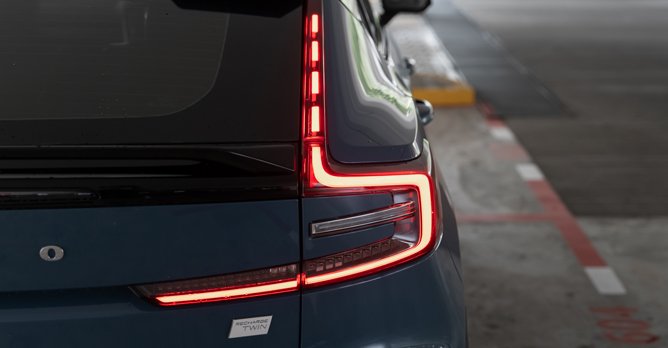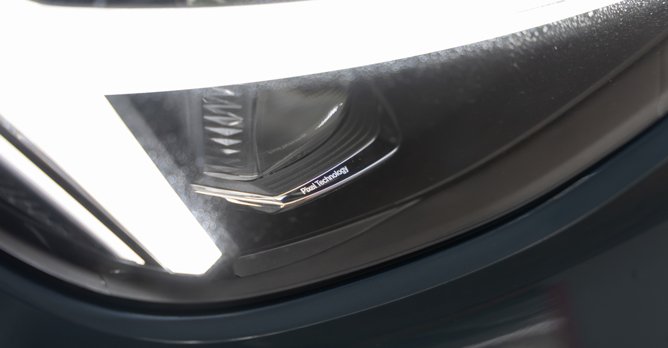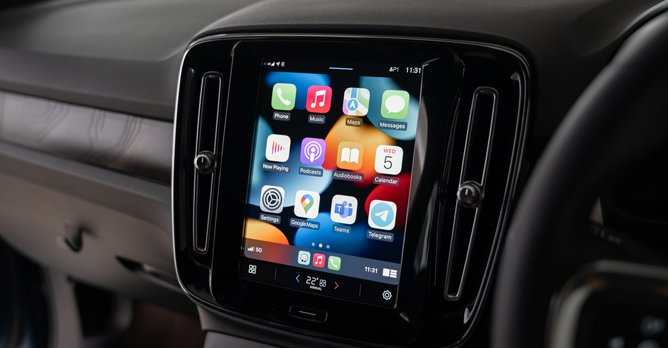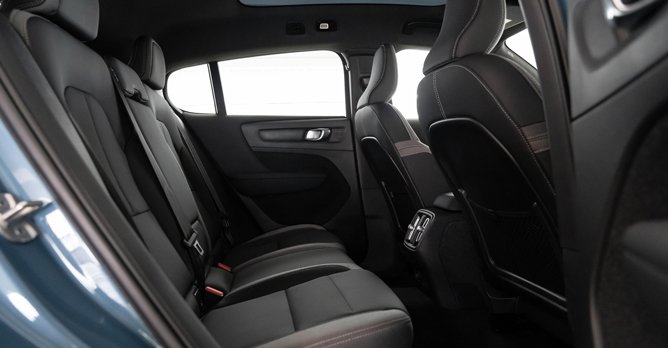Volvo C40 Recharge Electric 78kWh (A) Review
07 Oct 2022|10,081 views
What We Like
Seamless, intuitive controls
Striking looks
Responsive, quick acceleration
Feels hewn from granite
What We Dislike
Hefty mass
Could be more agile
Pricey
Readers who are of a certain vintage will remember the days when Nokia phones dominated the market.
Although there were other makes and models, the Finnish brand made using a mobile phone easy. Whether it was saving contacts or sending an SMS, using a Nokia was both seamless and intuitive.
I'm not sure if this is a Scandinavian thing, but it seems like Volvo took a page out of Nokia's playbook when it made the C40 Recharge.
If you're thinking of going electric, this is one of the easiest models to do it in, because getting the hang of it takes no time at all.
Swedish 'coupe-SUV'
The C40 Recharge is Volvo's first electric-only model, and it was designed from the ground up to only have an electric powertrain.
Its close relation, the XC40 Recharge, is available as either a plug-in hybrid or electric model.
Another big difference between the C40 and XC40 is the exterior design.
The C40 has a sportier body style, with the sloping roofline towards the rear giving the SUV a lower and sleeker profile.
Adding to the C40's distinct rear end are the taillights, and not one but two spoilers. There's one where the roof meets the glass, and another right on the short deck.
The C40 Recharge is the first Volvo model to get Pixel Technology Head Lights. Each headlamp features 84 Pixel LEDs that can switch on and off to adapt the car's light pattern.
Further adding to the C40's unique character are its wheels. Inspired by the ones on Volvo 360c concept, the wheels supposedly improve aerodynamics, which in turn helps increase range.
Slick intuition
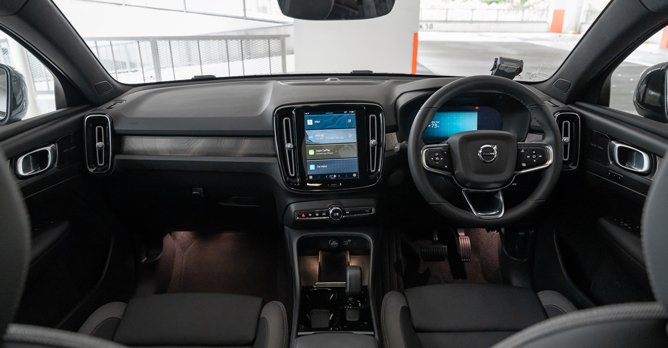
The cockpit's layout is driven by restraint and simplicity. Only the essential buttons and switches are offered, and getting to grips with the Android-powered infotainment system couldn't be any easier.
There's nothing to be afraid of here - you won't be inundated with myriad buttons and switches, or endless menus with even more options to tweak.
In my experience, all I had to do to sync my iPhone to the car was to connect it via a USB-C cable. In moments, my three most used apps - Waze, Spotify and Phone - were on screen. Tapping on their icons below switched between them.
As expected, Volvo's seats are the industry standard when it comes to comfort and support. And you don't have to keep fiddling to get the right driving position either.
Speaking of seats, the C40 is the first Volvo model to be completely leather-free.
In the carmaker's quest for sustainability, the topography trim panels are constructed from recycled plastic, and the carpets are made from 100% recycled PET bottles.
More importantly, the interior feels solidly assembled. There were no creaks or rattles (which will be very obvious in a silent EV) over the course of my 200+km drive.
Passengers in the backseat will be just as comfy, too. The rear bench features high seat backs that's good for taller folks, but the sloping roofline might cause occupants taller than 1.8m to seek more headroom.
The biggest bugbears back here though, are the relatively small door bins and lack of charging ports for the rear passengers. One might include the tight accommodations for the middle occupant, but perhaps Volvo gets a pass since this supposed to be a sporty 'coupe-SUV'.
'Poles' apart
Part of the C40's intuitive nature is how simple it is to drive. Once the car is unlocked, all you need to do is settle in behind the wheel, select 'D' and press the accelerator pedal.
A weight sensor in the driver's seat tells the car it's time to wake up and go. After you've parked, the electric handbrake automatically comes on. There's no On/Off switch. You just step out and lock the door.
Responsible for the C40's zippy nature is an electric motor that punches out 408bhp and 660Nm of torque. Feeding the motor is a 78kWh lithium-ion battery.
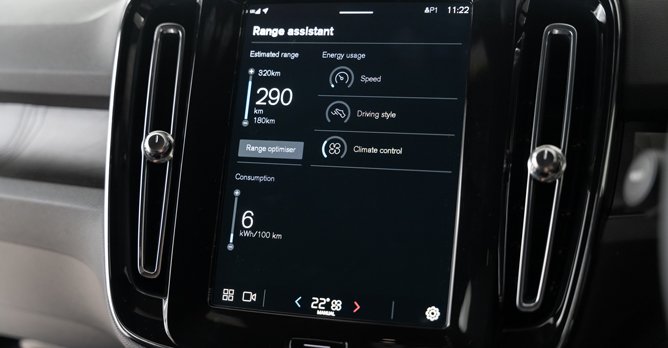
If these specifications sound familiar, it's because this powertrain is the same one found in the Polestar 2 Long Range Dual Motor.
It's no surprise then, that both the C40 and Polestar 2, which have all-wheel drive, can finish the century sprint in 4.7 seconds. But while the Polestar 2 tops out at 205km/h, the C40 is restricted to 180km/h.
But in spite of the lower top speed, the C40 has a slight edge over the Polestar 2: Its accelerator pedal feels more responsive.
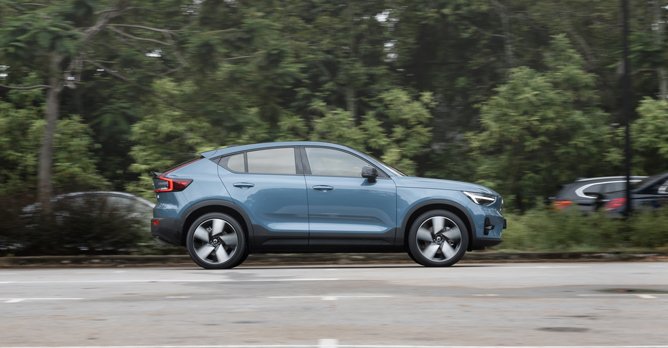
Making the C40 even easier to drive is the One-Pedal function. Whenever you lift off the accelerator, the regenerative braking will eventually slow the car down to a halt.
Once you get used to this, you'll know how to modulate the pedal such that you'll hardly need to step on the brake pedal. It's especially convenient and less tiring when you're crawling in traffic.
Swede dynamics
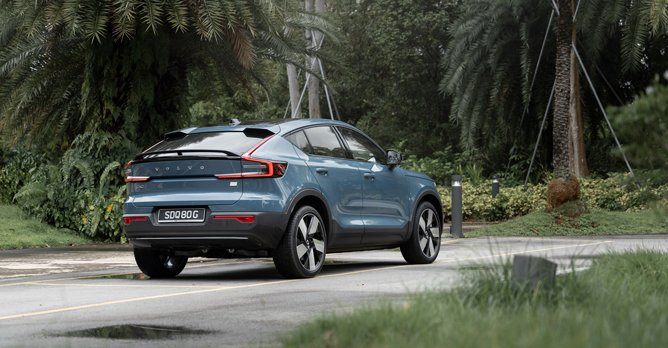
If you really insist on ham-fisted manoeuvres, then the C40 will try to adhere to your chosen line with its plentiful grip. Be warned that there will be lots of leaning when this happens.
That said, the C40, while neither sharp nor incisive, is actually fine. The target buyer, I'd imagine, places more emphasis on safety (the C40 has loads of features) and having a vault-like feel on the go.
If you've owned Volvos before, you'll definitely appreciate the hewn-from-granite feel that the C40 provides. There's a heft to it as well.
That reminds me of the original Nokia 3310. Like the mobile phone, the C40, too, has a solid feel, a long list of standard features, and a user-friendly interface. If this is your first electric vehicle, you'll be glad you made the switch.
Keen on electric SUVs? These stories may interest you
Mercedes EQA delivers quiet motoring and badge appeal
Volvo XC40 Recharge Pure Electric has decent space for all and more power than you need
Mercedes EQB350 combines an adaptable interior with an appealing outer body
BMW iX3 gets upgraded with new exterior design elements and more modern cabin equipment
Audi e-tron S Sportback lets you save trees while delivering ample space and pace
Catch more of the design and inteiror space of this Volvo C40 in our video review here!
What We Like
Seamless, intuitive controls
Striking looks
Responsive, quick acceleration
Feels hewn from granite
What We Dislike
Hefty mass
Could be more agile
Pricey
Readers who are of a certain vintage will remember the days when Nokia phones dominated the market.
Although there were other makes and models, the Finnish brand made using a mobile phone easy. Whether it was saving contacts or sending an SMS, using a Nokia was both seamless and intuitive.
I'm not sure if this is a Scandinavian thing, but it seems like Volvo took a page out of Nokia's playbook when it made the C40 Recharge.
If you're thinking of going electric, this is one of the easiest models to do it in, because getting the hang of it takes no time at all.
Swedish 'coupe-SUV'
The C40 Recharge is Volvo's first electric-only model, and it was designed from the ground up to only have an electric powertrain.
Its close relation, the XC40 Recharge, is available as either a plug-in hybrid or electric model.
Another big difference between the C40 and XC40 is the exterior design.
The C40 has a sportier body style, with the sloping roofline towards the rear giving the SUV a lower and sleeker profile.
Adding to the C40's distinct rear end are the taillights, and not one but two spoilers. There's one where the roof meets the glass, and another right on the short deck.
The C40 Recharge is the first Volvo model to get Pixel Technology Head Lights. Each headlamp features 84 Pixel LEDs that can switch on and off to adapt the car's light pattern.
Further adding to the C40's unique character are its wheels. Inspired by the ones on Volvo 360c concept, the wheels supposedly improve aerodynamics, which in turn helps increase range.
Slick intuition

The cockpit's layout is driven by restraint and simplicity. Only the essential buttons and switches are offered, and getting to grips with the Android-powered infotainment system couldn't be any easier.
There's nothing to be afraid of here - you won't be inundated with myriad buttons and switches, or endless menus with even more options to tweak.
In my experience, all I had to do to sync my iPhone to the car was to connect it via a USB-C cable. In moments, my three most used apps - Waze, Spotify and Phone - were on screen. Tapping on their icons below switched between them.
As expected, Volvo's seats are the industry standard when it comes to comfort and support. And you don't have to keep fiddling to get the right driving position either.
Speaking of seats, the C40 is the first Volvo model to be completely leather-free.
In the carmaker's quest for sustainability, the topography trim panels are constructed from recycled plastic, and the carpets are made from 100% recycled PET bottles.
More importantly, the interior feels solidly assembled. There were no creaks or rattles (which will be very obvious in a silent EV) over the course of my 200+km drive.
Passengers in the backseat will be just as comfy, too. The rear bench features high seat backs that's good for taller folks, but the sloping roofline might cause occupants taller than 1.8m to seek more headroom.
The biggest bugbears back here though, are the relatively small door bins and lack of charging ports for the rear passengers. One might include the tight accommodations for the middle occupant, but perhaps Volvo gets a pass since this supposed to be a sporty 'coupe-SUV'.
'Poles' apart
Part of the C40's intuitive nature is how simple it is to drive. Once the car is unlocked, all you need to do is settle in behind the wheel, select 'D' and press the accelerator pedal.
A weight sensor in the driver's seat tells the car it's time to wake up and go. After you've parked, the electric handbrake automatically comes on. There's no On/Off switch. You just step out and lock the door.
Responsible for the C40's zippy nature is an electric motor that punches out 408bhp and 660Nm of torque. Feeding the motor is a 78kWh lithium-ion battery.

If these specifications sound familiar, it's because this powertrain is the same one found in the Polestar 2 Long Range Dual Motor.
It's no surprise then, that both the C40 and Polestar 2, which have all-wheel drive, can finish the century sprint in 4.7 seconds. But while the Polestar 2 tops out at 205km/h, the C40 is restricted to 180km/h.
But in spite of the lower top speed, the C40 has a slight edge over the Polestar 2: Its accelerator pedal feels more responsive.

Making the C40 even easier to drive is the One-Pedal function. Whenever you lift off the accelerator, the regenerative braking will eventually slow the car down to a halt.
Once you get used to this, you'll know how to modulate the pedal such that you'll hardly need to step on the brake pedal. It's especially convenient and less tiring when you're crawling in traffic.
Swede dynamics

If you really insist on ham-fisted manoeuvres, then the C40 will try to adhere to your chosen line with its plentiful grip. Be warned that there will be lots of leaning when this happens.
That said, the C40, while neither sharp nor incisive, is actually fine. The target buyer, I'd imagine, places more emphasis on safety (the C40 has loads of features) and having a vault-like feel on the go.
If you've owned Volvos before, you'll definitely appreciate the hewn-from-granite feel that the C40 provides. There's a heft to it as well.
That reminds me of the original Nokia 3310. Like the mobile phone, the C40, too, has a solid feel, a long list of standard features, and a user-friendly interface. If this is your first electric vehicle, you'll be glad you made the switch.
Keen on electric SUVs? These stories may interest you
Mercedes EQA delivers quiet motoring and badge appeal
Volvo XC40 Recharge Pure Electric has decent space for all and more power than you need
Mercedes EQB350 combines an adaptable interior with an appealing outer body
BMW iX3 gets upgraded with new exterior design elements and more modern cabin equipment
Audi e-tron S Sportback lets you save trees while delivering ample space and pace
Catch more of the design and inteiror space of this Volvo C40 in our video review here!
Thank You For Your Subscription.



















































